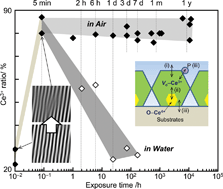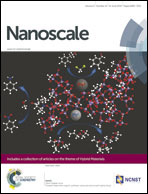Air, aqueous and thermal stabilities of Ce3+ ions in cerium oxide nanoparticle layers with substrates†
Abstract
Abundant oxygen vacancies coexisting with Ce3+ ions in fluorite cerium oxide nanoparticles (CNPs) have the potential to enhance catalytic ability, but the ratio of unstable Ce3+ ions in CNPs is typically low. Our recent work, however, demonstrated that the abundant Ce3+ ions created in cerium oxide nanoparticle layers (CNPLs) by Ar ion irradiation were stable in air at room temperature. Ce valence states in CNPs correlate with the catalytic ability that involves redox reactions between Ce3+ and Ce4+ ions in given application environments (e.g. high temperature in carbon monoxide gas conversion and immersion conditions in biomedical applications). To better understand the mechanism by which Ce3+ ions achieve stability in CNPLs, we examined (i) extra-long air-stability, (ii) thermal stability up to 500 °C, and (iii) aqueous stability of Ce3+ ions in water, buffer solution and cell culture medium. It is noteworthy that air-stability of Ce3+ ions in CNPLs persisted for more than 1 year. Thermal stability results showed that oxidation of Ce3+ to Ce4+ occurred at 350 °C in air. Highly concentrated Ce3+ ions in ultra-thin CNPLs slowly oxidized in water within 1 day, but stability was improved in the cell culture medium. Ce3+ stability of CNPLs immersed in the medium was associated with phosphorus adsorption on the Ce3+ sites. This study also illuminates the potential interaction mechanisms of stable Ce3+ ions in CNPLs. These findings could be utilized to understand catalytic mechanisms of CNPs with abundant oxygen vacancies in their application environments.


 Please wait while we load your content...
Please wait while we load your content...